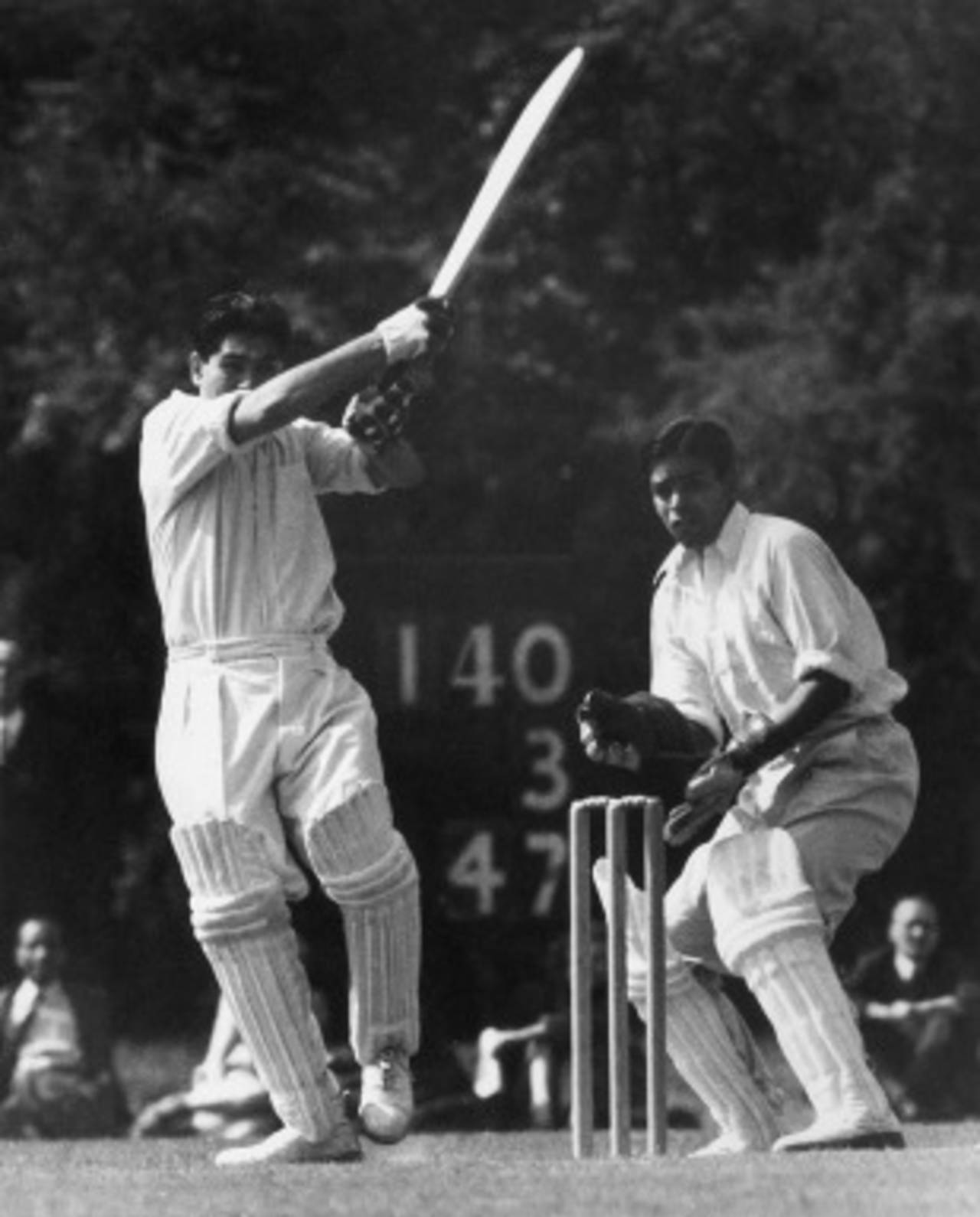First-class highs, and many double-centurions
Also: Sangakkara's 190s, West Indies' overseas players, and ODIs in which all ten were caught

Dattu Phadkar scored two hundreds in the first-class match with the highest aggregate • Getty Images
Sangakkara, who was out for 192 in the second Test in Colombo after being stranded on 199 not out in Galle the previous week, is the third batsman to score 190s in successive Tests. The first was Younis Khan, with 199 in Lahore and 194 in Faisalabad against India in January 2006. Later that year Younis' middle-order partner Mohammad Yousuf achieved the feat too: he made 192 in Lahore and 191 in Multan against West Indies in November. Two Tests previously, against England at Headingley, Yousuf had scored 192, so made three 190s in the space of four matches (he hit 128 in the intervening match, and 102 and 124 in the next one). Sangakkara, who also scored 192 against Australia in Hobart in November 2007, joins Yousuf as the only batsmen with three 190s in Tests. Mohammad Azharuddin, Ian Chappell, Rahul Dravid, Herschelle Gibbs, Brian Lara, Ricky Ponting, Sachin Tendulkar (one not out), Marcus Trescothick, Michael Vaughan, Everton Weekes, Frank Worrell (both not out) and Younis Khan all made two.
Kumar Sangakkara has indeed scored 150 or more against all nine possible opponents: he completed his set with 219 against India in Colombo in July 2010. In that same match, Sachin Tendulkar completed his own full set, with an innings of 203. The first - and only other - man to complete this set was Steve Waugh, who completed his nap hand with 156 not out against Bangladesh in Cairns in July 2003. The current player nearest to a full set (which has only been possible since Bangladesh's entry into Test cricket in 2000) is Jacques Kallis, whose highest score in 26 Tests against Australia is 114; he also falls slightly short against Bangladesh, with 139 not out. Seven other batsmen - Marvan Atapattu, Rahul Dravid, Adam Gilchrist, Mahela Jayawardene, Gary Kirsten, Brian Lara and Ricky Ponting - have scored Test centuries against all nine possible opponents. Matthew Hayden also hit Test hundreds against nine different teams, but one of them was the World XI: his highest against Bangladesh was 72.
My first thought was that some of those Australian sides that had Adam Gilchrist lurking at No. 7 must have bettered this, but actually they didn't: the record is six double-centurions in the same Test side. This was first achieved by Sri Lanka in their three-Test series in England in 2002, when the batting order included Marvan Atapattu, Aravinda de Silva, Sanath Jayasuriya, Mahela Jayawardene, Kumar Sangakkara and Hashan Tillakaratne. That record was equalled by India in three Tests in 2008, against Australia and South Africa, with Rahul Dravid, Sourav Ganguly, VVS Laxman, Virender Sehwag and Sachin Tendulkar being joined in two Tests by Wasim Jaffer and in another by Gautam Gambhir.
The aggregate in that famous ten-day drawn Test in Durban - 1981 runs for 35 wickets - is indeed the Test record, but it lies third on the overall list for first-class cricket. The two higher aggregates both came in India: in 1944-45, Bombay's Ranji Trophy final against Holkar produced 2078 runs. But the grand-daddy of them all remains the five-day Ranji Trophy semi-final in Poona in March 1949. Bombay started by scoring 651 (Sunil Gavaskar's uncle Madhav Mantri made 200, Vijay Merchant's brother Uday 143, and Dattu Phadkar 131). Maharashtra replied with 407 (Manohar Datar 143, Madhusudan Rege 133). Bombay, with the first-innings lead that almost guaranteed them a place in the final, had no need for a challenging declaration, and eventually called a halt at 714 for 8 (Merchant added 156 and Phadkar 160). Actually it was quite a challenging declaration, as Maharashtra were left needing to score 959 to win! They made a pretty fair effort, reaching 604: Rege made 104 and Sharad Deodhar 146. Bombay eventually won by 354 runs: their Test slow left-armer Keki Tarapore took 9 for 299 in the match, which featured a grand total of 2376 runs.
The nuggety left-hander Brendan Nash, who was born in Attadale, Western Australia, to Jamaican parents in December 1977, is indeed the only West Indian Test cricketer to have emerged from Australia. Nash, currently out of favour with the selectors, scored two centuries in 21 Tests between December 2008 and June 2011. The other West Indian Test players born outside the Caribbean are George Headley (born in Panama), Courtney Browne (London) and Kenneth "Bam Bam" Weekes (USA).
That instance at Eden Park in 1989-90 was the second time that all ten wickets in a one-day international innings had fallen to catches. The first was in Colombo in 1985-86, when all ten Sri Lankans were caught by Pakistan fielders - three of them by Imran Khan and four by the wicketkeeper, Zulqarnain. There have been 12 further examples of this, the most recent being by New Zealand against India in Guwahati in November 2010. That match also provided the record number of catches in a single ODI - 19. The only man not to be out caught was Ashish Nehra, who was run out by a direct hit from Ross Taylor.
Steven Lynch is the editor of the Wisden Guide to International Cricket 2012. Ask Steven is now on Facebook